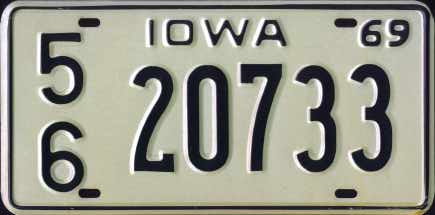
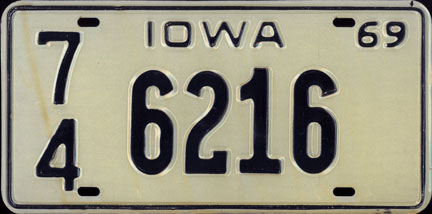
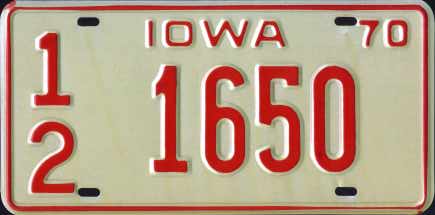
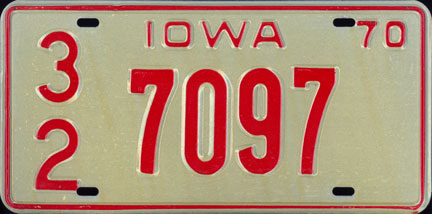
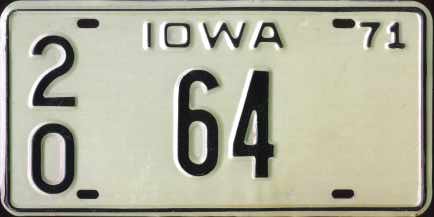
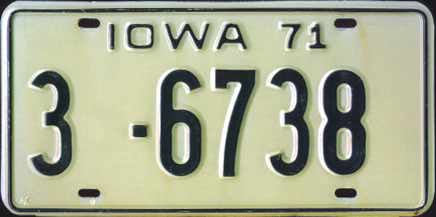
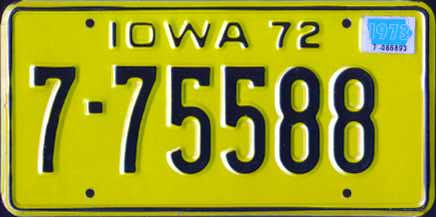
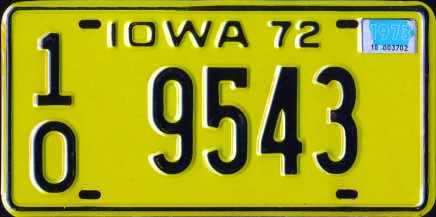
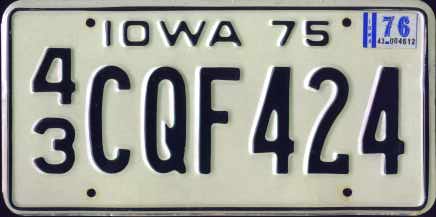
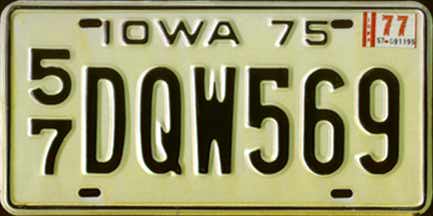
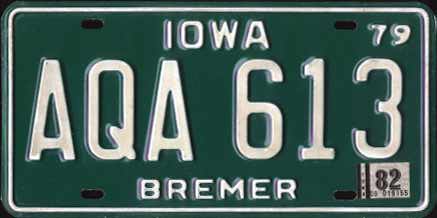
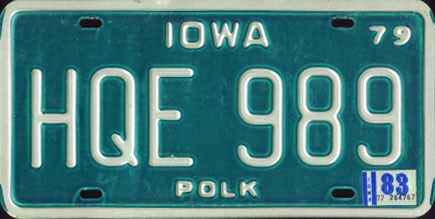
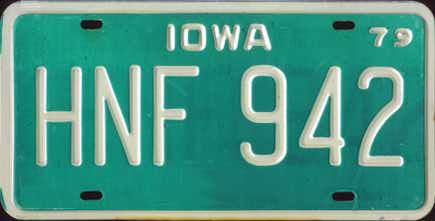
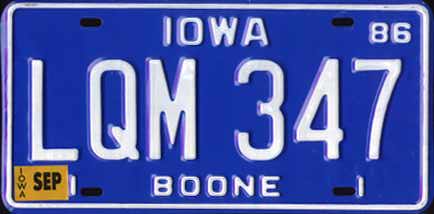
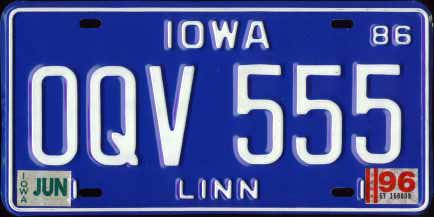
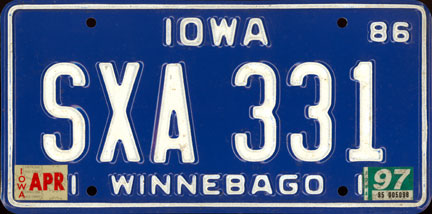
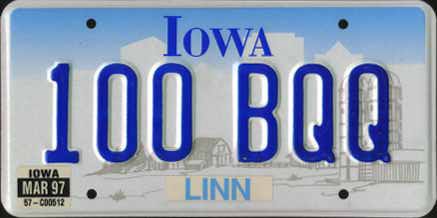
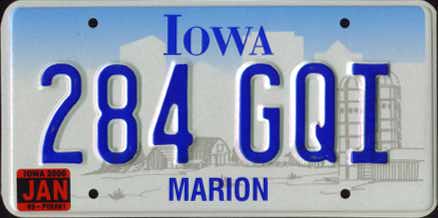
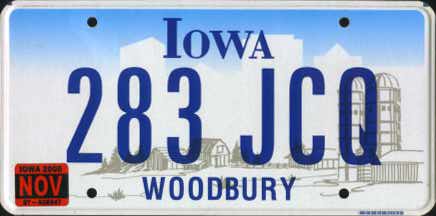
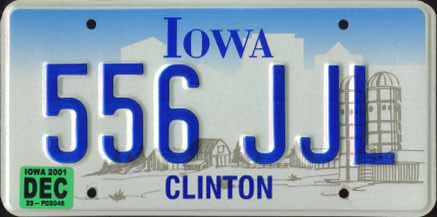
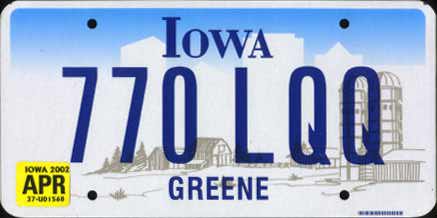
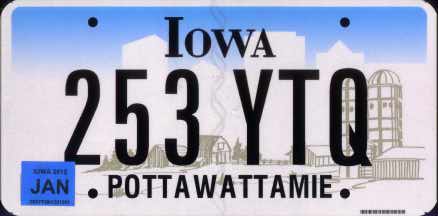
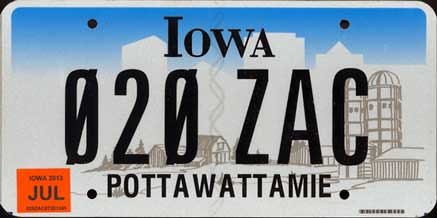
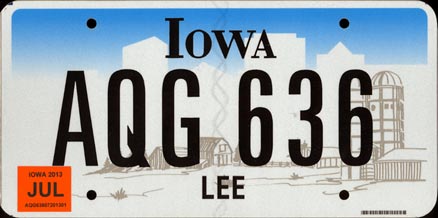
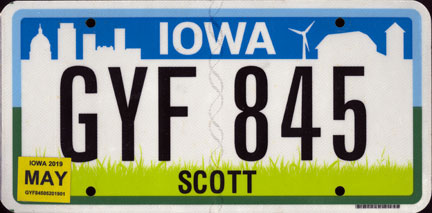

 |
Iowa 1969 passenger issue. Iowa plates carried a numeric county code (issued to the state's 99 counties in alphabetical order) from 1922 through 1979. This plate was issued in county #56, Lee county. These plates had the capacity for up to six digits after the county code, so plates were all numeric, starting at serial #1 in each county code. Click here for a complete listing of Iowa county codes. |
 |
Iowa 1969 passenger issue. Continuation of the 1969 issue, some late issues in the state were produced using older, wider serial dies that had been in use from 1959 through 1966. |
 |
Iowa 1970 passenger issue. Same idea as above, this plate was issued in Butler county, #12. |
 |
Iowa 1970 passenger issue. The same die variation that occurred in 1969 was also seen on some late 1970 plates where the older, wider dies were broken out once again. This was a later issue in Emmet county, #32. |
 |
Iowa 1971 passenger issue. Identical to the 1969 issue aside from the date. Iowa alternated between black-on-white and red-on-white from 1967 through 1971. This plate is a low-number issue from Clarke county, #20. This was the last yearly issue for Iowa. |
 |
Iowa 1971 passenger issue. This was a variation on the 1971 Iowa plate, with the state name and date centered at the top as opposed to having the year in the top right corner. Plates of this design were likely produced late in the year, after production of the 1972 issue had already begun, thus the format change. This plate was issued in Allamakee county, #3. |
 |
Iowa 1973 passenger issue (1972 base). This plate was issued at the end of 1971 to all motorists and was used through the end of 1974 with stickers. It follows the same format as earlier issues, but with a sticker box added at the top right. One-digit county codes such as this one from county #7, Black Hawk, had a full-size county code character and a dash before the serial. Some of these plates were produced with round bolt holes such as this one, while others had oval slots like the next. |
 |
Iowa 1973 passenger issue (1972 base). Another 1973 Iowa, this one was issued in county #10, Buchanan, and has the stacked two-digit county code and no dash. This plate was produced with the bolt slots rather than round holes. I'm not sure why there was a difference. |
 |
Iowa 1976 passenger issue (1975 base). For this new issue, Iowa retained the stacked numeric county code, but rather than using a distinct all-numeric serial set for each county, they used a more standard ABC123 format, with the series running statewide with different letter blocks assigned to each county. Therefore, all serial numbers in the state were unique regardless of county code. This plate was issued in county #43, Harrison county. This county happened to be near the middle of the "C" series letter allocation. |
 |
Iowa 1977 passenger issue (1975 base). Again on this base some plates were produced with round bolt holes, while others featured oval bolt slots. This was a "slot" plate, issued late in the series in Linn county (#57). |
 |
Iowa 1982 passenger issue (1979 base). At the end of 1978, new baseplates were issued to all motorists in two different designs. Half the counties received baseplates in an embossed white-on-green format like this one, and the other half received debossed white-on-green plates (see next). There does not seem to be a pattern to which county got which plates. County codes were eliminated in favor of embossed/debossed county names at the bottom of the plate. An ABC-123 format was again used, with each county getting an allocation of letters. This series reached approximately the "K" series before it was replaced at the end of 1985. This plate was from Bremer county. |
 |
Iowa 1983 passenger issue (1979 base). Debossed variety of the 1979 Iowa baseplate. This plate was issued in Polk county. |
 |
Iowa 1979 passenger issue. Some 1979 bases were also issued without an indentifying county name at the bottom, these were a continuation of the long-standing practice of issuing non-resident plates. These previously would have been issued with a 00 county code under the old system, with some issues specifically captioned Non-Resident as well. These identifiers were left off the 1979 base, however, leading to some confusion as to the plates' origin. |
 |
Iowa 1986 passenger issue. At the end of 1985, new plates in this format were issued to all residents. These plates were very similar to the 1979 embossed issues, with different colors, date, and the addition of two marks to indicate sticker placement at the bottom corners. Plates were used with a month sticker only for 1986 (with the embossed "86" obviously handling the year designation), then with year stickers thereafter. This baseplate started off where the 1979 series had left off in the number sequence, around LAA-001, and was used in Iowa through the end of 1996. This plate was from Boone county. |
 |
Iowa 1996 passenger issue (1986 base). Late issue on the 1986 baseplate, showing the use of a year sticker in the lower right corner of the plate. This base was issued through the end of 1995. This particular plate was issued in Linn county. |
 |
Iowa 1997 passenger issue (1986 base). Some counties apparently ran low on 1986 bases at the very end of the plate's run after production of the 1996 base had already begun, resulting in passenger plates being made on the old base with the new narrower dies. This was such a plate from Winnebago county near the end of their 1986-base letter block. |
 |
Iowa 1997 passenger issue. This new graphic plate was issued beginning in 1996. It again features a "rural meets urban" motif with a farm scene in the foreground and the shape of a city skyline at the back. These plates used county stickers rather than embossed county names, giving more flexibility in plate issuance. The state also switched to a single sticker for month and year on these plates. This one is from Linn county. |
 |
Iowa 2000 passenger issue. Continuation of the above baseplate, Iowa switched from using county names on stickers to screening the county name directly onto the baseplate at some point in the "G" series of plates. This results in a "cleaner" looking plate, but is more difficult from a plate production and distribution standpoint. |
 |
Iowa 2000 passenger issue. After having used the Azon-Utsch flat plate production method for a few years on special issues and vanities, Iowa began experimenting with producing flat A-U passenger plates in 1999. Plates in some counties were issued as flats, with others remaining embossed. After this experimentation in the H and J series of plates, it appears that Iowa is currently issuing all new passenger plates using the Azon-Utsch flat plate method, which I find somewhat troubling, as this marked the first state to begin using flat plates for all types of plates (I hate flat plates). |
 |
Iowa 2001 passenger issue. Due to some plates being produced out of sequence due to the distribution by county system, there isn't a clean break in the alpha sequence where the flat plates start and the embossed ones end. Some counties have flat plates back into the Hxx and Jxx series, while others were still issuing embossed plates, like this one, into the mid to late Jxx series. I believe all counties were converted to flat plates by the time of the Kxx series, much of which was skipped due to an apparent clerical error (there's a big gap between "KCZ" and "KZC," which seems like too much of a coincidence not to attribute to transposed characters on a plate order.) |
 |
Iowa 2002 passenger issue. And it gets worse. Plates starting somewhere in the "L" series, now produced using 3M's digital flat plate technology, have somehow managed to get even flimsier and cheaper. The earlier flat plates, such as the "JCQ" plate above, used a heavier stock of aluminum and a beveled edge to provide some stability to the plate. This newer plate is noticeably lighter than the older ones, is completely flat (no embossed edge at all) and can be flapped around in the breeze quite easily by giving it a good shake. I think the state is one step away from converting to cardboard, myself. |
 |
Iowa 2012 passenger issue. After 10 years without any major changes, Iowa made some tweaks to this base late in 2011. The design remains unchanged, but the printed elements (state name, county name and serial) were changed from dark blue to black. There must be a cost savings in this move, as a handful of other states including Minnesota and Idaho have also changed designs to use black on their flat plates. This also indicates that the state name is printed along with the serial on these plates, I'd always assumed it was part of the graphic sheeting. These black plates are reported to have started after the YPM series. |
 |
Iowa 2013 passenger issue. At some point shortly after swapping to black print on these plates, an additional change was made to the plate, adding a slash to the zero character. This was supposedly in anticipation of an upcoming change to a reversed ABC-123 format to more easily differentiate letters and numbers between series. In reality, the effect was less successful - the slash-zero character looks for all the world like an '8' at a distance of more than a couple carlengths. Oops. |
 |
Iowa 2013 passenger issue. As noted above, upon running out of serials in the previous format after 999 ZZZ in 2012, the state flipped back to a ABC 123 format. This format was last used on the 1979-85 and 1986-97 bases. Plate design remained otherwise unchanged, including the ill-advised slash-zero character. |
 |
Iowa 2019 passenger issue. In 2017, Iowa released a new graphic base with a blue skyline at top and green grass at the bottom. This new plate began in the late G series, where the previous issue left off. |
Additional Iowa information provided by: Pete Cinquegrana
| Ahead to Kansas | |
| Back to Indiana |
Return to U.S. Plates Index
Last Modified 1/20/2020 (added second 1970 plate).